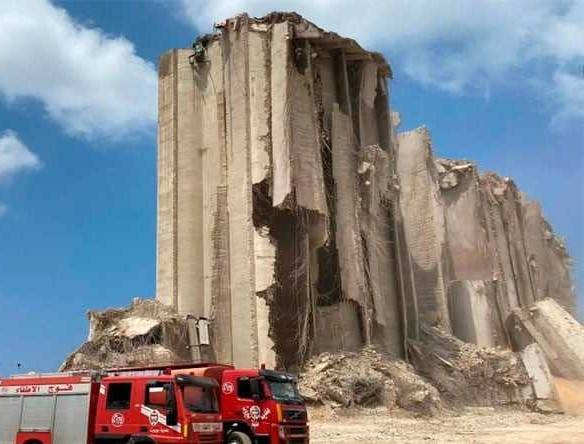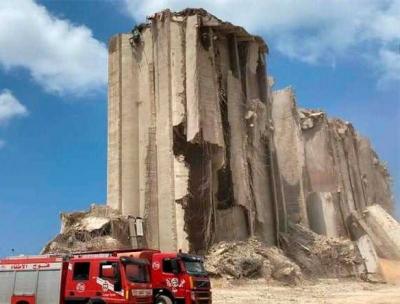It has been three years and nine months since the explosion at the Port of Beirut, and there has been no significant movement to start a genuine reconstruction effort, except for what took place on March 13, when the Ministry of Public Works and Transport announced the special offer for the Beirut Port reconstruction and development plan prepared by France, with costs ranging between 50 and 100 million dollars at maximum. The caretaker Prime Minister, Najib Mikati, emphasized at that time that reviving and reconstructing the Port of Beirut remained a national and economic priority, as this port is the most vital artery on the Mediterranean Sea and into the Arab depth. Since that date, the file of the port's reconstruction has returned to a deep sleep, similar to what is happening with all the required reform files to emerge from the crisis, as the International Monetary Fund conditions cooperation with Lebanon on the implementation of reforms.
Despite media reports since the explosion about international bids for reconstruction from Russia, China, Turkey, France, and Germany, the government denied this, stating that these remain mere expressions of intention from these entities, especially amid numerous obstacles.
### A Political Decision
A specialized source explains that reconstruction is a political decision, as the port occupies a vast area of 1.3 million square meters on Beirut's waterfront, which is an essential aspect before reaching architectural details and building construction. The rehabilitation of the port relates to two parts: the container terminal, which was not damaged, and the problematic part, which includes the site where victims fell, comprising the port building and grain silos.
The source points out contradictions in the visions regarding the nature of the reconstruction, as some believe the economic dimension is the sole aspect of the port's rehabilitation. However, civil society organizations and those concerned with urban planning and unions hold a different perspective, arguing that the port is not just an economic site for the transit of goods.
### Three Obstacles
For his part, the Secretary-General of the Citizens in a State movement, former Minister Charbel Nahas, explains to "Nidaa Al-Watan" that there are three obstacles preventing the kickoff of the port's reconstruction. The first is the explosion and the humanitarian aspect related to the victims, along with finding an alternative for the silos for grain storage. The second is the open appetite of the political establishment and its affiliates to reduce the areas included, as due to the increasing use of containers, goods storage has become vertical, reducing the need for extensive storage space, resulting in unused surplus. There’s a desire from the political establishment to seize portions of the port land to convert them into real estate projects.
He adds that the third obstacle is the changed function of Beirut Port. After being the port for the entire region, including Syria, Iraq, and Jordan, goods to these countries no longer come from Europe except in limited quantities, but are now imported in larger amounts from China and East Asia to UAE ports and then to regional countries. Additionally, the deteriorating political and security situations in both Syria and Iraq also contribute to a reduction in the activity of the Port of Beirut regionally.
He concludes that the factors contributing to the failure to launch the Beirut Port reconstruction can be summarized by the decline in its regional significance, the regional turmoil, the real estate appetite of individuals to seize portions of it, and the humanitarian aspect of the explosion. All of these factors are interrelated and delay the reconstruction process, with what has been achieved so far being only the delegation of management to the CMA-CGM company.
### Lack of Vision
Economic expert Dr. Mohammed Farida points out to "Nidaa Al-Watan" that the investigation into the explosion is not yet complete. In addition to political and factional reasons, there is a lack of vision and the large investments needed for reconstruction. It is unclear if the port will be reconstructed to be managed in the same way as before the explosion, without a regulatory authority or new vision in terms of management and governance, while opening portions of it as public spaces. He notes that numerous questions remain unanswered, as is the case with many files in the country, including a lack of serious and scientific approaches to improving public facilities.
On another note, there were attempts by CMA to take over reconstruction of part of the port. Minister of Public Works Ali Hamieh was trying to begin self-reconstruction from the port’s revenues, which is a challenging task. Furthermore, the absence of an agreement on how to share the port's "cake" is an obstacle, and this reflects the modus operandi of the political establishment.
Farida insists that there needs to be a vision for the port's future role and how it will serve the city (in addition to concluding the legal path). These topics can be discussed by the government and the Ministry of Public Works to initiate attracting investments. When this vision is established and a regulatory authority for managing the port is created, alongside implementing governance principles in its management instead of being overseen by a committee of politicians that turns it into a corruption funnel, all of these steps will encourage foreign investors to submit serious offers for reconstruction. He concludes that under the current situation, he doubts that any progress will occur not only regarding the port but with all files in the country.
It is worth noting that Minister Hamieh previously stated that the revival of the Port of Beirut must pass through three stages: activation, reform, and reconstruction, asserting that the third stage is the crown jewel in completing the revival of this vital facility, highlighting that they approached this stage by navigating national lines that consider the port's role and their current and future vision for it, while reflecting on its history, location, and surroundings, maintaining that they would never accept any plans that would remove the port from its role, history, and location. They would also not accept any projects or schemes that would strip the port of its identity or extend it beyond its geographical boundaries to neighboring properties, emphasizing their desire for this plan to consider all this while working to serve the public good for both the state and its people.




